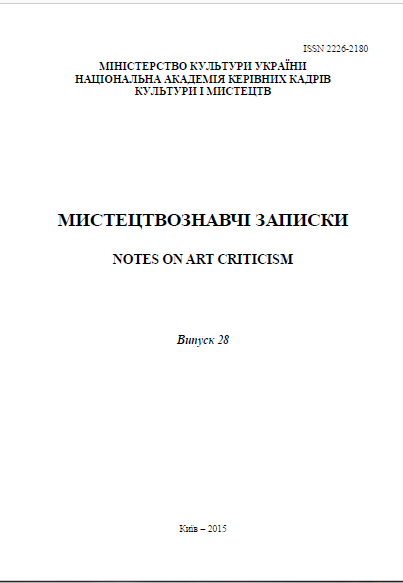"Пластика" та "пластичність" як мистецтвознавчі категорії
"Plastic" and "plasticity" as a category of art theory
Author(s): Rada MykhailovaSubject(s): Cultural history, Architecture, Visual Arts
Published by: Національна академія керівних кадрів культури і мистецтв
Keywords: plastic; plasticity; category; sculpture; architecture; choreography; art history;
Summary/Abstract: Identification of the content of certain terms and concepts as раrt of categorical apparatus, is one of the important tasks of science. The basic terms of art history is "plastic" and "plasticity" related graphic, decorative, design, architectural, stage entertainment perspective. Disclosure of the nature of their content, the analysis of a specific interpretation of professional, scientific and general educational level show that both terms are widely used in different areas of artistic practice, but most of the wording of the explanation is schematic and superficial. The current level of science to clarify and deepen this scientific definition. The term "plastic" often associated with the visual arts, which include spatial, visual (apparent), based on the fact that their works are substantive in nature, there are material by treating the material and are thought to exist in space. Traditionally, visual arts include painting, sculpture, graphics that make up the complex visual arts, architecture and applied art that reflect the real world materialized in specific forms of artistic activity – utilitarian three-dimensional objects endowed with artistic features. The spatial forms of plastic volumes and lines are essential, as this quality is their basis is the fundamental difference from other art forms such as music, literature, theater, cinema, whose works were perceived by ear, "expanding" in time are synthesized with a variety of visual representations. However, plasticity is an important component of synthetic, entertainment arts – screen and stage, including ballet-dance. The main quality of plasticity is the ability to deform under mechanical stress. In visual and spatial arts – a specific processing of materials in different ways is to achieve spatial configurations, identify their sculpture and paintings, material and texture, imagery and stylistic properties of structuring work and so on.
Journal: Мистецтвознавчі записки
- Issue Year: 2015
- Issue No: 28
- Page Range: 143-152
- Page Count: 10
- Language: Ukrainian

